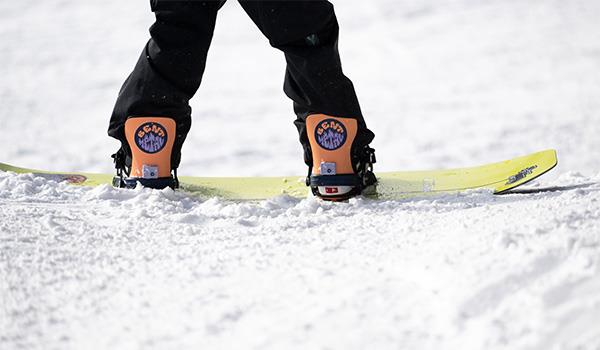
A snowboard’s profile refers to the board's shape while looking at it from the side. You’ll notice that snowboards are not completely flat to the ground. These curves in the board are known as rocker and camber. Different boards have different amounts of rocker, camber, or a mix of both to influence how the board will perform.
Rocker
Rocker is the downward curve that lifts the board’s tip and tail off the snow. Rocker helps with turn initiation and floating on top of lighter snow. A softer board with more rocker is a great choice for beginners as they begin to learn and gain confidence on the mountain. Boards with more rocker are also popular among more advanced powder riders due to their float and maneuverability in lighter and deeper snow.

Camber
Camber is the upward curve that lifts the board off the snow. In most camber boards, the camber lifts the center of the board, between your feet. As you roll the board on edge to turn, the camber flattens under the combination of the rider’s weight and strength. As you move out of the turn, the board wants to return to its camber shape. This is noticeable on groomed trails, creating pop, liveliness, and responsiveness.

The more camber a board has, the longer the effective edge, or the amount of the board’s edge in contact with the ground. A longer effective edge gives the board good edge hold and more stability at speed and hard packed runs.
Flat
A flat board has no rocker or camber. There is a slight lift in the tip and tail to keep the ends of the board from catching on snow, but other than that, the board is flat to the snow. Flat snowboards make a great choice for beginners since they’re more forgiving of mistakes, easier to maneuver, and the board’s edges are less likely to catch.

Flat Rocker
Flat Rocker has a flat profile with more rocker in the tip and tail, lifting the ends off the board more than a traditional flat board. This added rocker in the tip and tail helps with turn initiation.
Rocker Camber / Hybrid
As you progress, you may be interested in looking for boards that combine different amounts of rocker and camber to fine-tune how the board will ride. Commonly referred to as hybrid, snowboards are designed with different amounts of rocker and camber to reap the benefits of each and create a uniquely performing board for different types of terrain. Hybrid boards are a great choice for those looking for an all-mountain and freeride boards.
Back to Top